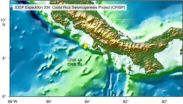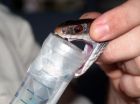(Press-News.org) Puntarenas, Costa Rica – New samples of rock and sediment from the depths of the eastern Pacific Ocean may help explain the cause of large, destructive earthquakes similar to the Tohoku Earthquake that struck Japan in mid-March.
Nearly 1500 meters (almost one mile) of core collected from the ocean floor near the coast of Costa Rica reveal detailed records of approximately 2 million years of tectonic activity along a seismic plate boundary.
The samples were retrieved with the scientific drilling vessel JOIDES Resolution during the recent month-long Integrated Ocean Drilling Program (IODP) Costa Rica Seismogenesis Project (CRISP) Expedition. Participating scientists aim to use the samples better understand the processes that control the triggering of large earthquakes at subduction zones, where one plate slides beneath another.
"We know that there are different factors that contribute to seismic activity – these include rock type and composition, temperature differences, and how water moves within the Earth's crust," explained co-chief scientist Paola Vannucchi (University of Florence, Italy), who led the expedition with co-chief scientist Kohtaro Ujiie (University of Tsukuba, Japan).
She added, "but what we don't fully understand is how these factors interact with one another and if one may be more important than another in leading up to different magnitudes of earthquakes. This expedition provided us with crucial samples for answering some of these fundamental questions."
More than 80% of global earthquakes above magnitude 8.0 occur along subduction zones. The Pacific Ocean is famous for these boundaries, known as convergent margins, which are found along the coasts of the East Pacific from Alaska to Patagonia, New Zealand, Tonga, Marianas all the way up to Japan and the Aleutians, making the margins of the world's largest ocean basin a primary target for research into the triggering mechanisms of large quakes.
During four weeks at sea, the science party and crew successfully drilled four sites, recovering core samples of sand and clay-like sediment and basalt rock. In a preliminary report published this month, CRISP scientists say that they have found evidence for a strong subsidence, or sinking, of the Costa Rica margin combined with a large volume of sediment discharged from the continent and accumulated in the last 2 million years.
"The sediment samples provide novel information on different parameters which may regulate the mechanical state of the plate interface at depth," said Ujiie. He adds, "knowing how the plates interact at the fault marking their boundary is critical to interpreting the behavior and frequency of earthquakes in the region."
Vannucchi explains, "for example we now know that fluids from deeper parts of the subduction zone system have percolated up through the layers of sediment. Studying the composition and volume of these fluids, as well as how they have moved through the sediment helps us better understand the relationship between the chemical, thermal, and mass transfer activity in the seafloor and the earthquake-generating, or seismogenic, region of the plate boundary. They may be correlated."
Cores from the CRISP Expedition are currently being further analyzed by different members of the research party at their home institutions. The scientists will meet beginning August 29 at Texas A&M University to share their initial results.
The CRISP Expedition is unique because it focuses on the properties of erosional convergent margins, where the overriding plate gets "consumed" by subduction processes. These plate boundaries are characterized by trenches with thin sediment cover (less than 400 meters), fast convergence between the plates (at rates greater than 8 centimeters per year), and abundant seismicity.
The seismically active CRISP research area is the only one of its kind that is accessible to research drilling. However, this subduction zone is representative of 50% of global subduction zones, making scientific insights gleaned here relevant to Costa Ricans and others living in earthquake-prone regions all around the Pacific Ocean. The recent Tohoku Earthquake in Japan was generated in an erosive portion of the plate interface.
Other geoscience research drilling programs, such as IODP's Nankai Trough Seismogenic Zone Experiment (NantroSEIZE), near the southeast coast of Japan, focus on accretionary margins, where the front part of the overriding tectonic plate is built up by the subduction processes (sometimes forming mountains) and the plate boundary input is trench material. In these environments, the trench sediments are significantly thick (greater than 1000 meters or over a half a mile). Accretionary margins are known for their large earthquakes as the 1964 Alaska and the 2004 Sumatra quakes. Japan's Nankai Trough itself was the center of two magnitude 8 earthquakes in 1944 and 1946.
The CRISP team hopes to return to the same drill site in the future to directly sample the plate boundary and fault zone before and after seismic activity in the region. Changes observed through this work may provide new insights into how earthquakes are generated.
INFORMATION:
About IODP
The Integrated Ocean Drilling Program (IODP) is an international research program dedicated to advancing scientific understanding of the Earth through drilling, coring, and monitoring the subseafloor. The JOIDES Resolution is a scientific research vessel managed by the U.S. Implementing Organization of IODP (USIO). Together, Texas A&M University, Lamont-Doherty Earth Observatory of Columbia University, and the Consortium for Ocean Leadership comprise the USIO. CHIKYU is a drilling vessel operated by JAMSTEC/CDEX (Japan), and mission-specific platforms are supplied by ECORD (the European Consortium for Ocean Research Drilling). IODP is supported by two lead agencies: the U.S. National Science Foundation (NSF) and Japan's Ministry of Education, Culture, Sports, Science, and Technology (MEXT). Additional program support comes from the European Consortium for Ocean Research Drilling (ECORD), the Australian-New Zealand IODP Consortium (ANZIC), India's Ministry of Earth Sciences, the People's Republic of China (Ministry of Science and Technology), and the Korea Institute of Geoscience and Mineral Resources.
Useful Websites:
For more information about the IODP Louisville Seamount Trail Expedition, visit http://iodp.tamu.edu/scienceops/expeditions/costa_rica_seismogenesis.html.
For more information about the JOIDES Resolution, visit www.joidesresolution.org.
For more information about the Integrated Ocean Drilling Program, visit www.iodp.org.
Media Contacts:
Kris Ludwig
Consortium for Ocean Leadership, Washington DC USA
kludwig@oceanleadership.org
+1-202-448-1254
Miyuki Otomo
Integrated Ocean Drilling Program Management International, Inc. (IODP-MI), Tokyo, Japan
motomo@iodp.org
+81-3-6701-3188
Scientists study earthquake triggers in Pacific Ocean
2011-06-30
ELSE PRESS RELEASES FROM THIS DATE:
Debenhams Launches Lightest Ever Bra
2011-06-30
Debenhams has launched its lightest ever t-shirt bra, weighing in at just 48g, as the answer to the perfect everyday bra.
Debenhams head of lingerie buying and design, Sharon Webb commented: "Many women find that the search for a bra that fits, flatters, is comfortable and functional, is as hard as finding the right man.
"Our research showed that many traditional t-shirt bras were quite heavy due to their dense foam structure, which is required to give an invisible fit."
Over 90% of women in wearer trials agreed that the bra felt like a second skin.
Back ...
Heavy metal meets hard rock: Battling through the ocean crust's hardest rocks
2011-06-30
Panama City, Panama – Integrated Ocean Drilling Program (IODP) Expedition 335 Superfast Spreading Rate Crust 4 recently completed operations in Ocean Drilling Program (ODP) Hole 1256D, a deep scientific borehole that extends more than 1500 meters below the seafloor into the Pacific Ocean's igneous crust – rocks that formed through the cooling and crystallization of magma, and form the basement of the ocean floor.
An international team of scientists led by co-chief scientists Damon Teagle (National Oceanographic Center Southampton, University of Southampton in the UK) ...
Debenhams Reveals British Tourists are Marking Their Territory on the Beach
2011-06-30
Debenhams, the high street store, has revealed that super-sized beach towels, able to occupy extra room on crowded shores and sun loungers are soaring in popularity.
Customers are using them to mark out more territory during holidays, providing a better defence against incursions from rival tourists fighting for space in the most popular resorts.
The new towels are up to 65 per cent bigger than normal, and designed using distinctive, bold, bright colours, making it obvious that the space is already occupied, even when the owner isn't there.
Debenhams spokeswoman, ...
Russell Investments Launches New Online Information Suite
2011-06-30
Russell Investments has launched a new dedicated website specifically for retail financial advisers.
The new online portal, available direct from the Russell Investments UK homepage, brings together the most relevant investment information from Russell's extensive range of detailed and unbiased industry analysis and allows financial advisers to cut through the noise to hone in on the topics which are important to them.
Alongside this, advisers will be able to quickly navigate through Russell's tools and investment services which can help them get under the bonnet ...
Antivenom against lethal snake gives hope to developing countries
2011-06-30
Researchers from the Australian Venom Research Unit (AVRU) at the University of Melbourne have collaborated with scientists from the University of Papua New Guinea and the University of Costa Rica, to develop new antivenom against the lethal Papuan taipan.
The preclinical studies of this antivenom have been published in the international journal PLoS Neglected Tropical Diseases.
Around 750 people are bitten in PNG each year. PhD candidate David Williams from AVRU, who coordinated the project in PNG, said snakebite is a neglected public health problem compounded by antivenom ...
Prudential Reveals Retirement Income Gender Gap is GBP6,500 a Year
2011-06-30
Prudential has announced that men retiring in 2011 expect to receive 50 per cent more pension income than women, according to new Prudential's Class of 2011 research.
Prudential's Class of 2011 research surveyed people planning to retire this year and found that the retirement income gender gap is GBP6,500. The average woman retiring this year expects an annual income of GBP12,900 compared with an average expected male income of GBP19,400.
There is some good news for women though as the retirement income gender gap has shrunk since last year when Prudential's study ...
Many a mickle makes a muckle: How changes in animals' size and shape arise
2011-06-30
The transcription of genes is tightly controlled, with a bewildering array of regulatory DNA sequences interacting with a similarly large number of proteins and other factors to determine which genes are active when and where. Understanding how it all works has challenged countless molecular biologists over the past decades but we are now starting to make significant progress. Even so, we have scarcely begun to understand how the entire complexity evolves to give differences in the size and shape of organisms. Exciting new findings are now reported by the group of David ...
elephant.co.uk Reveals Young Men Have More Expensive Car Crashes
2011-06-30
elephant.co.uk has revealed that while many men like to think they are the superior gender when it comes to driving, new research from the car insurance specialist shows men have bigger crashes that cost more money than women.
elephant.co.uk looked at more than 200,000 claims and found young men in particular have more expensive crashes. Accidents involving men aged under 25 cost on average 15% more than those involving women of the same age. In fact, the cost of accidents involving male drivers of all ages is 6% higher than accidents involving women.
To help improve ...
Using DNA in fight against illegal logging
2011-06-30
Advances in DNA 'fingerprinting' and other genetic techniques led by Adelaide researchers are making it harder for illegal loggers to get away with destroying protected rainforests.
DNA fingerprinting for timber products has grown in international recognition due to research led by the University of Adelaide that traces individual logs or wood products back to the forests where they came from.
Professor Andrew Lowe, Director of the University's Australian Centre for Evolutionary Biology and Biodiversity, and Dr Hugh Cross, Molecular Biologist at the State Herbarium ...
British Airways Launches New Flights to Faro and Malaga Direct from London City
2011-06-30
British Airways has announced the launch of two new routes to Faro and Malaga and added more frequency to the popular destinations of Nice, Palma and Ibiza. This means that British Airways now offers 39 leisure flights per week for this summer from London City Airport to top sun destinations at the height of the season.
The four times a week flights to Faro and the three times a week flights to Malaga are now both in operation and will operate year round.
The existing Nice service has been increased to double daily flights from May until September, and from July to ...



